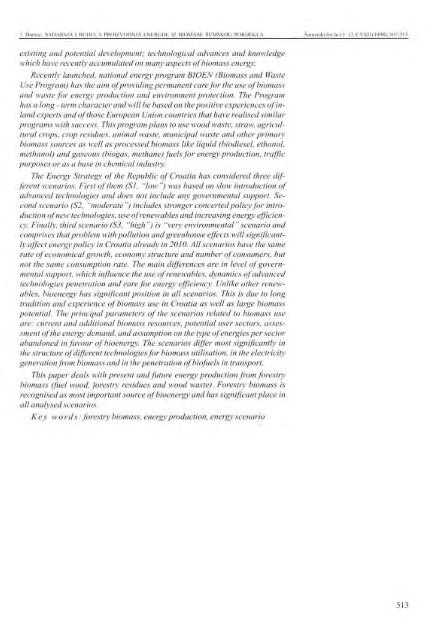Create successful ePaper yourself
Turn your PDF publications into a flip-book with our unique Google optimized e-Paper software.
J. Doinac: SADAŠNJA I BUDUĆA PROIZVODNJA ENERGIJI- IZ BIOMASE ŠUMSKOG PORIJEKLA Šumarski list br. I 1-<strong>12</strong>. CXXI1 (<strong>1998</strong>). 507-5 13<br />
existing and potential development; technological advances and knowledge<br />
which have recently accumulated on many aspects ofbiomass energy.<br />
Recently launched, national energy program BIOEN (Biomass and Waste<br />
Use Program) has the aim of providing permanent care for the use ofbiomass<br />
and waste for energy production and environment protection. The Program<br />
has a long - term character and will be based on the positive experiences of inland<br />
experts and of those European Union countries that have realised similar<br />
programs with success. This program plans to use wood waste, straw, agricultural<br />
crops, crop residues, animal waste, municipal waste and other primary<br />
biomass sources as well as processed biomass like liquid (biodiesel, ethanol,<br />
methanol) and gaseous (biogas, methane) fuels for energy production, traffic<br />
purposes or as a base in chemical industry.<br />
The Energy Strategy of the Republic of Croatia has considered three different<br />
scenarios. First of them (SI, "low ") was based on slow introduction of<br />
advanced technologies and does not include any governmental support. Second<br />
scenario (S2, "moderate ") includes stronger concerted policy for introduction<br />
of new technologies, use ofrenewables and increasing energy efficiency.<br />
Finally, third scenario (S3, "high ") is "very environmental" scenario and<br />
comprises that problem with pollution and greenhouse effects will significantly<br />
affect energy policy in Croatia already in 2010. All scenarios have the same<br />
rate of economical growth, economy structure and number of consumers, but<br />
not the same consumption rate. The main differences are in level of governmental<br />
support, which influence the use ofrenewables, dynamics of advanced<br />
technologies penetration and care for energy efficiency. Unlike other renewables,<br />
bioenergy has significant position in all scenarios. This is due to long<br />
tradition and experience ofbiomass use in Croatia as well as large biomass<br />
potential. The principal parameters of the scenarios related to biomass use<br />
are: current and additional biomass resources, potential user sectors, assessment<br />
of the energy demand, and assumption on the type of energies per sector<br />
abandoned in favour of bioenergy. The scenarios differ most significantly in<br />
the structure of different technologies for biomass utilisation, in the electricity<br />
generation from biomass and in the penetration ofbiofuels in transport.<br />
This paper deals with present and future energy production from forestry<br />
biomass (fuel wood, forestry residues and wood waste). Forestry biomass is<br />
recognised as most important source of bioenergy and has significant place in<br />
all analysed scenarios.<br />
Key words: forestry biomass, energy production, energy scenario<br />
513
















